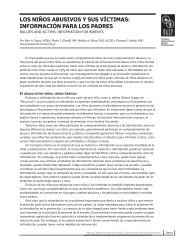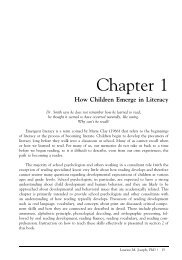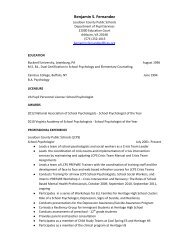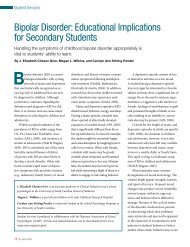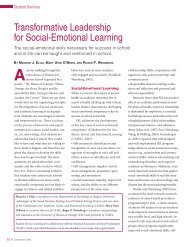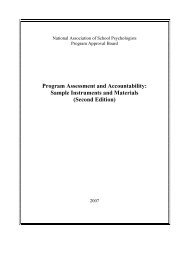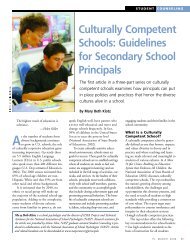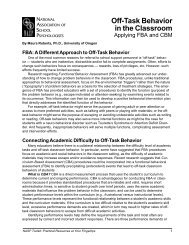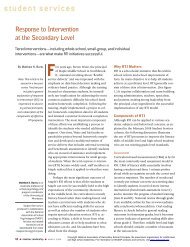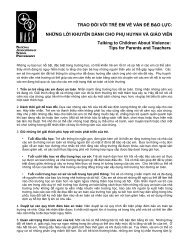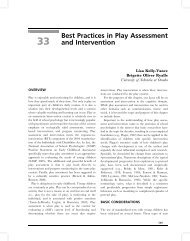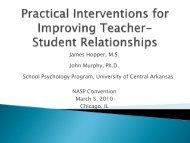Self-Concept and Self-Esteem in Adolescents - National Association ...
Self-Concept and Self-Esteem in Adolescents - National Association ...
Self-Concept and Self-Esteem in Adolescents - National Association ...
Create successful ePaper yourself
Turn your PDF publications into a flip-book with our unique Google optimized e-Paper software.
Figure 1<br />
Reduc<strong>in</strong>g the Availability of Social Comparison Cues<br />
Area of Practice Method to Reduce Social Comparisons<br />
Grad<strong>in</strong>g <strong>and</strong><br />
evaluation<br />
Group<strong>in</strong>g<br />
Tasks<br />
Assessments. Assess students’ selfconcept<br />
us<strong>in</strong>g theoretically sound,<br />
empirically validated <strong>in</strong>struments before<br />
<strong>in</strong>vest<strong>in</strong>g time, money, <strong>and</strong> effort<br />
try<strong>in</strong>g to correct deficits that may not<br />
exist. Use the results of the assessment<br />
to determ<strong>in</strong>e whether <strong>in</strong>tervention is<br />
warranted <strong>and</strong>, if so, whether it should<br />
be directed toward the classroom, the<br />
student, the home, or a comb<strong>in</strong>ation<br />
thereof. Tra<strong>in</strong>ed school mental health<br />
professionals should conduct <strong>and</strong> <strong>in</strong>terpret<br />
these assessments <strong>and</strong> work with<br />
the student support team to implement<br />
<strong>and</strong> evaluate <strong>in</strong>terventions.<br />
Placement decisions. Ensure that<br />
special education teams do not make<br />
placement decisions on the basis of the<br />
presumed effects of a particular sett<strong>in</strong>g<br />
on self-concept. Although <strong>in</strong>clusive sett<strong>in</strong>gs<br />
are often assumed to protect selfconcept<br />
by reduc<strong>in</strong>g the stigmatization<br />
associated with placement <strong>in</strong> a separate<br />
special education classroom, two recent<br />
meta-analyses fail to support this, at<br />
least for students with learn<strong>in</strong>g disabilities<br />
(Bear, M<strong>in</strong>ke, & Mann<strong>in</strong>g, 2002;<br />
Elbaum, 2002).<br />
The two reviews also failed to support<br />
the opposite assumption, that<br />
<strong>in</strong>clusive sett<strong>in</strong>gs may be more damag<strong>in</strong>g<br />
to students’ self-concept because<br />
14 PL February 2007<br />
Make grades private, not public (e.g., do not post grades or “best work”).<br />
Allow students to improve grades by redo<strong>in</strong>g work.<br />
Avoid grad<strong>in</strong>g that allows only a few students to achieve high grades (e.g., use of normal curve).<br />
Avoid use of ability groups for <strong>in</strong>struction.<br />
Make group membership flexible; allow for movement from one group to another.<br />
Provide <strong>in</strong>dividualized tasks at which all students can be successful.<br />
Reduce emphasis on competition aga<strong>in</strong>st other students; emphasize improvement over the<br />
student's prior performance.<br />
of negative comparisons with higherachiev<strong>in</strong>g<br />
peers (Bear et al., 2002; Elbaum,<br />
2002). Students are most likely to<br />
experience enhanced self-concept when<br />
they are placed <strong>in</strong> an academic sett<strong>in</strong>g<br />
where they f<strong>in</strong>d the greatest success.<br />
Interventions. Interventions should<br />
be <strong>in</strong>dividualized but generally should<br />
<strong>in</strong>volve build<strong>in</strong>g students’ skills <strong>in</strong> areas<br />
<strong>in</strong> which they have deficits. For example,<br />
students who express low academic<br />
self-concept <strong>and</strong> experience read<strong>in</strong>g difficulties<br />
may benefit from <strong>in</strong>terventions<br />
designed to build their literacy skills.<br />
Students do not have to experience<br />
success <strong>in</strong> every possible doma<strong>in</strong> to<br />
develop adequate or high self-concept<br />
(Harter, 1999). They simply must experience<br />
success <strong>in</strong> a few doma<strong>in</strong>s that<br />
they value.<br />
Students may benefit from learn<strong>in</strong>g<br />
skills that not only <strong>in</strong>crease their<br />
competence <strong>in</strong> areas of importance but<br />
also help them ga<strong>in</strong> more support from<br />
others. Interventions that promote academic<br />
competence <strong>and</strong> better behavior<br />
will not only further core education<br />
objectives <strong>and</strong> school success but also<br />
can engender higher levels of parent<br />
support <strong>and</strong> consequently student selfconcept.<br />
It is important that schools<br />
also address doma<strong>in</strong>s that are valued by<br />
peers. Students who lack attributes <strong>in</strong><br />
these doma<strong>in</strong>s may benefit from <strong>in</strong>terventions<br />
that address these areas (Harter,<br />
1999), such as social skills tra<strong>in</strong><strong>in</strong>g<br />
or nutrition <strong>and</strong> exercise programs. In<br />
some cases, it may be most effective to<br />
help students reevaluate the importance<br />
they attach to particular sources of support.<br />
For example, students may need to<br />
discount the importance of the support<br />
they lack from the popular crowd <strong>and</strong><br />
focus on the support they receive from<br />
others.<br />
Sometimes students lack accurate<br />
perceptions of the skills or support<br />
they have. In such cases, students may<br />
benefit from therapeutic techniques<br />
that help them see that they are more<br />
competent or more supported than they<br />
believe. Research supports the effectiveness<br />
of cognitive-behavioral techniques<br />
for modify<strong>in</strong>g children’s self-perceptions<br />
when used by properly tra<strong>in</strong>ed<br />
<strong>in</strong>dividuals (Hattie, 1992). Pr<strong>in</strong>cipals<br />
should consult school psychologists <strong>and</strong><br />
counselors tra<strong>in</strong>ed <strong>in</strong> cognitive-behavioral<br />
<strong>in</strong>terventions regard<strong>in</strong>g the use of<br />
such techniques.<br />
Classroom <strong>in</strong>terventions. Classroom<br />
<strong>in</strong>terventions, such as peer tutor<strong>in</strong>g<br />
<strong>and</strong> cooperative learn<strong>in</strong>g, may<br />
promote self-concept by <strong>in</strong>creas<strong>in</strong>g stu-



